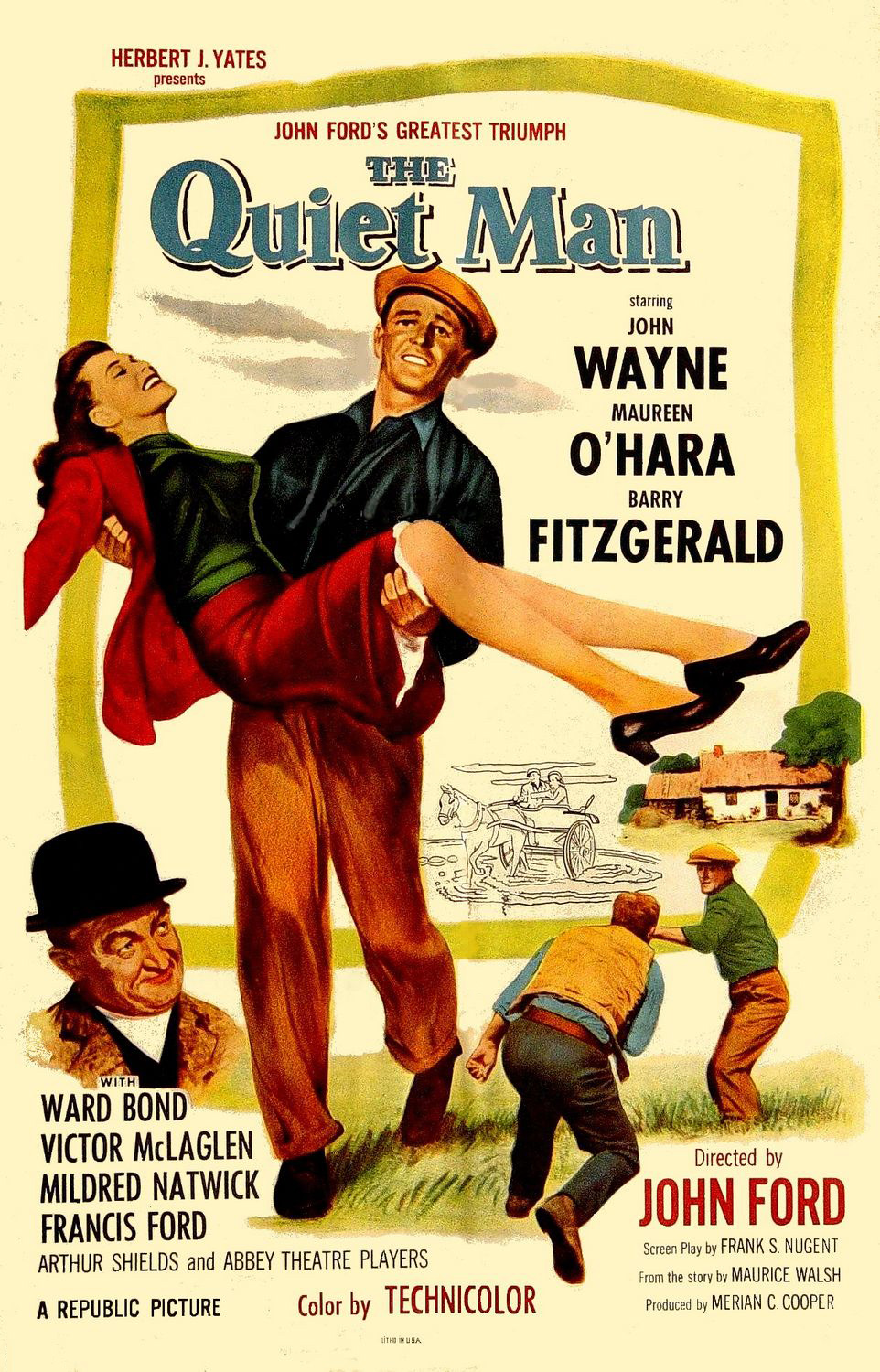By: Remy Nering
 The Quiet Man is a 1950s romantic comedy starring John Wayne and Maureen O’Hara. Sean Thornton (Wayne) returns home to Ireland from American to claim right to his childhood home but in the process, he angers a local man, Will Danaher, who wanted the land Thornton purchases for himself. To Danaher’s dismay, Thornton ends up falling in love with his sister, Mary Kate (O’Hara). With a little scheming by locals, Danaher agrees to permit Thornton and Mary Kate to marry. When the scheme is discovered, Danaher refuses to give Mary Kate her fortune which she deems necessary to be wed to Thornton. The fortune is of no consequence to Thornton, but Mary Kate will not stand to be with him if she does not have it. It’s only after Thornton confronts Danaher about the ridiculous custom of a fortune’s necessity that Danaher hands it over. Thornton then begins a fight with Danaher; the fight takes an intermission for the men to have a drink then ends shortly after with the two agreeing on grounds of mutual respect.
The Quiet Man is a 1950s romantic comedy starring John Wayne and Maureen O’Hara. Sean Thornton (Wayne) returns home to Ireland from American to claim right to his childhood home but in the process, he angers a local man, Will Danaher, who wanted the land Thornton purchases for himself. To Danaher’s dismay, Thornton ends up falling in love with his sister, Mary Kate (O’Hara). With a little scheming by locals, Danaher agrees to permit Thornton and Mary Kate to marry. When the scheme is discovered, Danaher refuses to give Mary Kate her fortune which she deems necessary to be wed to Thornton. The fortune is of no consequence to Thornton, but Mary Kate will not stand to be with him if she does not have it. It’s only after Thornton confronts Danaher about the ridiculous custom of a fortune’s necessity that Danaher hands it over. Thornton then begins a fight with Danaher; the fight takes an intermission for the men to have a drink then ends shortly after with the two agreeing on grounds of mutual respect.
World War II was over, the baby boom had begun, and the economy was growing in the 1950’s. This created justification for Americans to place the United States on a pedestal and argue it to be the best country on Earth, making movies about immigrants coming to America for a better life quite popular. The Quiet Man, however, is about a man who could not wait to leave America and start a better life in Ireland.
Although it may not be critically acclaimed as the most famous movie directed by John Ford, Ford himself refers to it has his favorite movie.[1] He believed it was “the sexiest picture ever…with honesty, good taste, and humor[2].” Ford’s opinions of his movie were not far off. Opening of the film was followed by positive reviews: The New York Times called it “as darlin’ a picture as we’ve seen this year”, its visual effects were acclaimed, it won three Venice Film Festival awards[3], and awards for Best Director[4] and Best Cinematography.[5] Clearly the film was well received, lending a positive image to Ireland – a place worthy of immigration from America.
Aesthetic beauty was not the only factor in making Ireland alluring. Not by modern day, but by 1950’s cinematic standards, The Quiet Man is remarkably feminist: Mary Kate is a strong-willed female character who stands up for herself and her principles. Mary Kate’s fortune symbolizes her independence, and she does not rest, or allow Thornton to share a home with her, until her brother relinquishes it. Mary Kate and Thornton torch the money in a furnace after receiving it to further prove the point it was never about the money, it was about the principle behind it.
The country of Ireland was not enamored with the film like the United States. The Irish opinion matches present day standards: it was a sexist movie with horribly stereotyped characters. The movie boosted tourism to Ireland significantly[6], and the Irish did not squander the portrayal of their culture in the movie, but instead capitalized on the opportunity. The Quiet Man Holiday Centre was opened in County Mayo to lure tourists. The Quiet Man Cottage Museum is an incredibly accurate replica of the movie-set cottage where fans of the movie may learn about what it was like in Cong when Hollywood invaded to film. The bed & breakfast’s rooms are named after movie characters, interactive tours are offered in which people reenact movie scenes, ghost tours are available, and O’Hara and the family of John Wayne have visited the museum[7].
The Quiet Man painted Ireland as a beautiful oasis more worthy than America as a place to call home. Surely Americans found themselves asking how any country could provide a better life than the United States, and flocked to Ireland on vacation to experience the quiet countryside for themselves.
Works Cited
- Kehr, Dave. “John Ford’s Portraits of Loss and Redemption.” The New York Times. N.p., 09 Feb. 2013. Web. 18 Feb. 2017.
- “The 25th Academy Awards | 1953.” Oscars.org. N.p., n.d. Web. 18 Feb. 2017.
- “The Quiet Man (1952) – Articles.” Turner Classic Movies. N.p., n.d. Web. 18 Feb. 2017.
- “Quiet Man Museum.” The Quiet Man Cong. N.p., n.d. Web. 18 Feb. 2017.
- Davis, Ronald L. John Ford: Hollywood’s Old Master. Norman: U of Oklahoma, 1995. 253. Print.
Photo References
- Delignieres, Eric. The Village of Cong in County Mayo, Ireland. N.d. Flickr. Web. 22 Feb. 2017.
- Delignieres, Eric. The Village of Cong in County Mayo, Ireland. N.d. Flickr. Web. 22 Feb. 2017.
[1] The Quiet Man
[2] Davis
[3] Davis
[4] Kehr
[5] The 25th Academy Awards
[6] Davis
[7] Quiet Man Museum